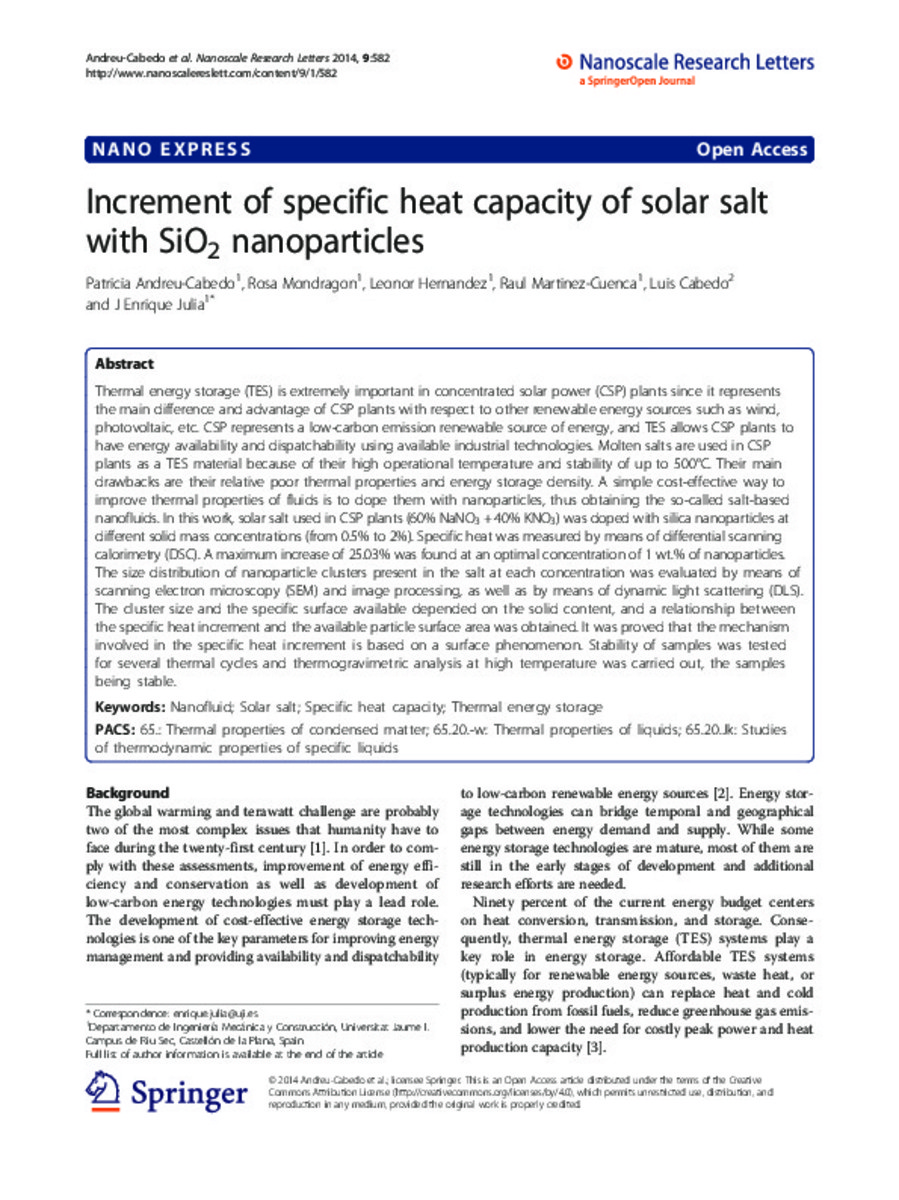Mostrar el registro sencillo del ítem
Increment of specific heat capacity of solar salt with SiO2 nanoparticles
| dc.contributor.author | Andreu Cabedo, Patricia | |
| dc.contributor.author | Mondragon, Rosa | |
| dc.contributor.author | Hernandez, Leonor | |
| dc.contributor.author | Martinez Cuenca, Raul | |
| dc.contributor.author | Cabedo, Luis | |
| dc.date.accessioned | 2015-05-18T12:23:00Z | |
| dc.date.available | 2015-05-18T12:23:00Z | |
| dc.date.issued | 2014 | |
| dc.identifier.citation | ANDREU-CABEDO, Patricia, et al. Increment of specific heat capacity of solar salt with SiO2 nanoparticles. Nanoscale research letters, 2014, vol. 9, no 1, p. 1-11. | ca_CA |
| dc.identifier.issn | 1931-7573 | |
| dc.identifier.issn | 1556-276X | |
| dc.identifier.uri | http://hdl.handle.net/10234/121104 | |
| dc.description.abstract | Thermal energy storage (TES) is extremely important in concentrated solar power (CSP) plants since it represents the main difference and advantage of CSP plants with respect to other renewable energy sources such as wind, photovoltaic, etc. CSP represents a low-carbon emission renewable source of energy, and TES allows CSP plants to have energy availability and dispatchability using available industrial technologies. Molten salts are used in CSP plants as a TES material because of their high operational temperature and stability of up to 500°C. Their main drawbacks are their relative poor thermal properties and energy storage density. A simple cost-effective way to improve thermal properties of fluids is to dope them with nanoparticles, thus obtaining the so-called salt-based nanofluids. In this work, solar salt used in CSP plants (60% NaNO3 + 40% KNO3) was doped with silica nanoparticles at different solid mass concentrations (from 0.5% to 2%). Specific heat was measured by means of differential scanning calorimetry (DSC). A maximum increase of 25.03% was found at an optimal concentration of 1 wt.% of nanoparticles. The size distribution of nanoparticle clusters present in the salt at each concentration was evaluated by means of scanning electron microscopy (SEM) and image processing, as well as by means of dynamic light scattering (DLS). The cluster size and the specific surface available depended on the solid content, and a relationship between the specific heat increment and the available particle surface area was obtained. It was proved that the mechanism involved in the specific heat increment is based on a surface phenomenon. Stability of samples was tested for several thermal cycles and thermogravimetric analysis at high temperature was carried out, the samples being stable. | ca_CA |
| dc.description.sponsorShip | Universitat Jaume I (project P1-1B2013-43) | ca_CA |
| dc.format.extent | 11 p. | ca_CA |
| dc.format.mimetype | application/pdf | ca_CA |
| dc.language.iso | eng | ca_CA |
| dc.publisher | Springer | ca_CA |
| dc.relation.isPartOf | Nanoscale research letters, 2014, vol. 9, no 1 | ca_CA |
| dc.rights | © 2014 Andreu-Cabedo et al.; licensee Springer. This is an Open Access article distributed under the terms of the Creative Commons Attribution License (http://creativecommons.org/licenses/by/4.0), which permits unrestricted use, distribution, and reproduction in any medium, provided the original work is properly credited. | ca_CA |
| dc.rights.uri | http://creativecommons.org/licenses/by-sa/4.0/ | |
| dc.subject | Nanofluid | ca_CA |
| dc.subject | Solar salt | ca_CA |
| dc.subject | Specific heat capacity | ca_CA |
| dc.subject | Thermal energy storage | ca_CA |
| dc.title | Increment of specific heat capacity of solar salt with SiO2 nanoparticles | ca_CA |
| dc.type | info:eu-repo/semantics/article | ca_CA |
| dc.identifier.doi | http://dx.doi.org/10.1186/1556-276X-9-582 | |
| dc.rights.accessRights | info:eu-repo/semantics/openAccess | ca_CA |
| dc.relation.publisherVersion | http://link.springer.com/article/10.1186%2F1556-276X-9-582 | ca_CA |
Ficheros en el ítem
Este ítem aparece en la(s) siguiente(s) colección(ones)
-
ESID_Articles [463]
-
EMC_Articles [804]
Excepto si se señala otra cosa, la licencia del ítem se describe como: © 2014 Andreu-Cabedo et al.; licensee Springer. This is an Open Access article distributed under the terms of the Creative Commons Attribution License (http://creativecommons.org/licenses/by/4.0), which permits unrestricted use, distribution, and reproduction in any medium, provided the original work is properly credited.








